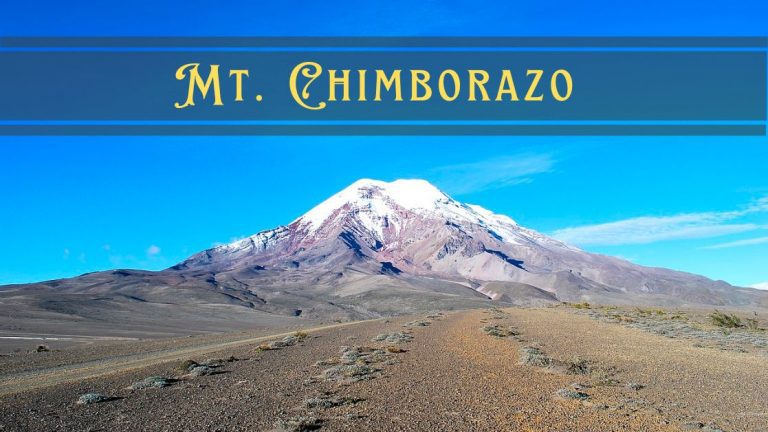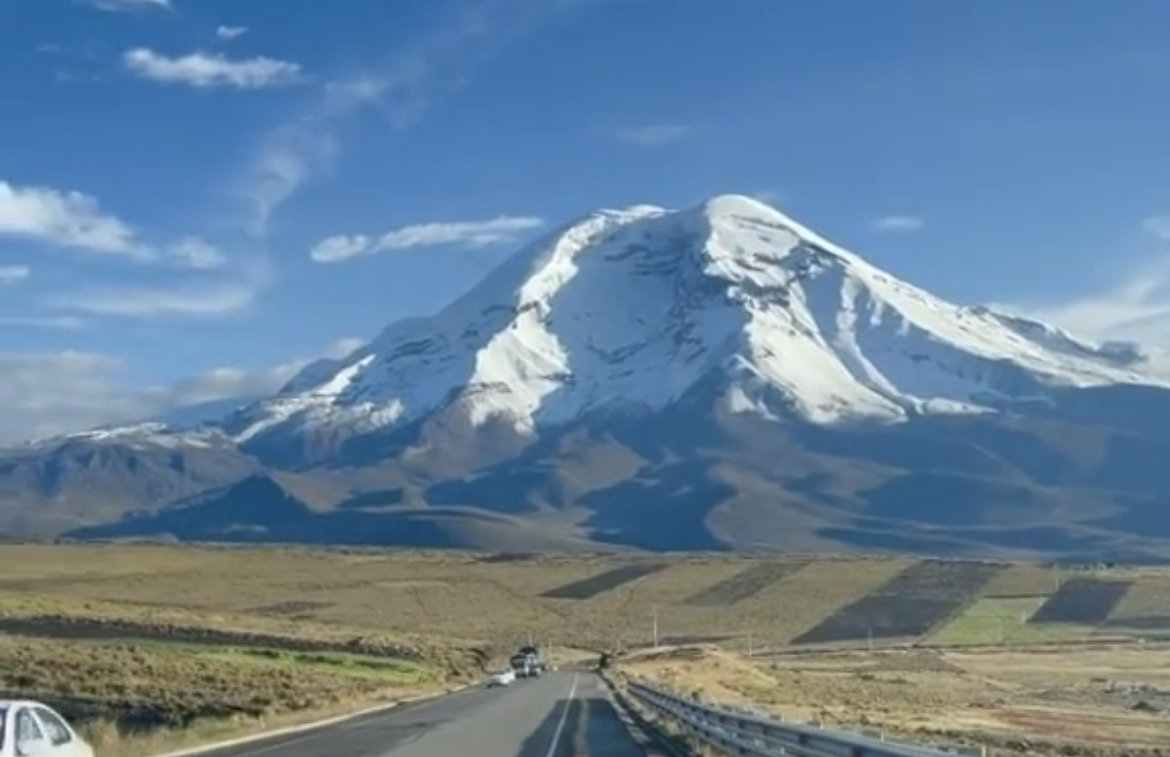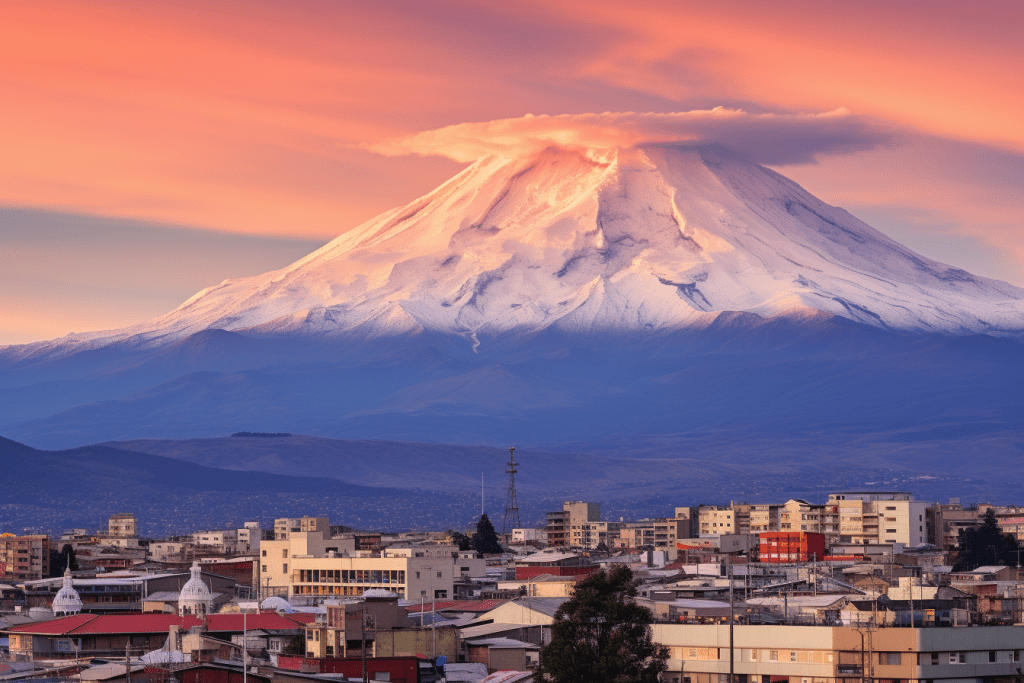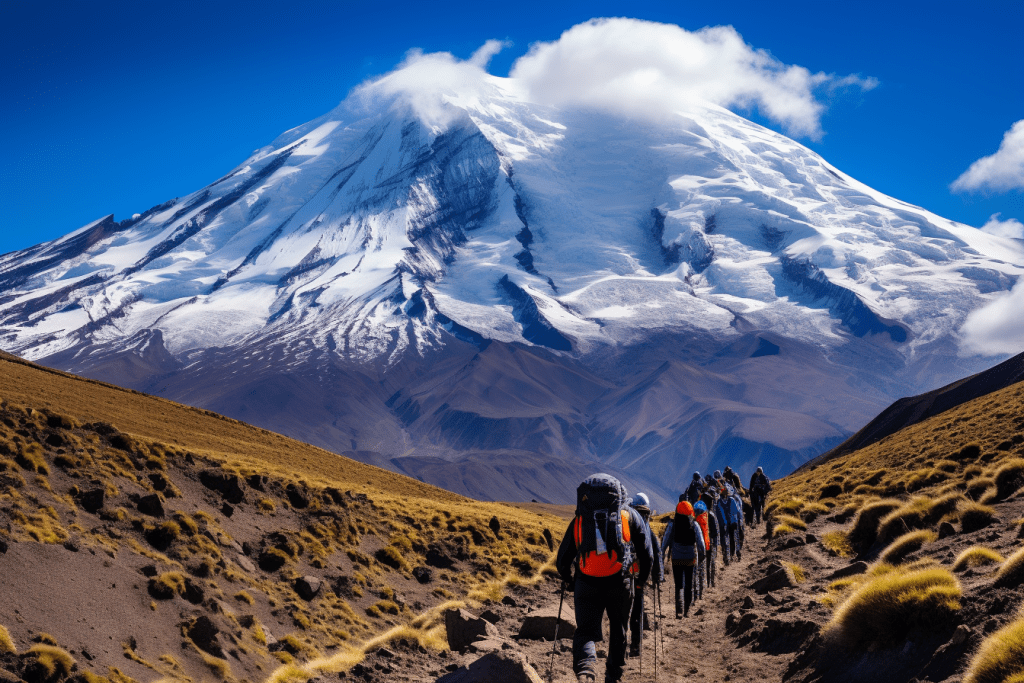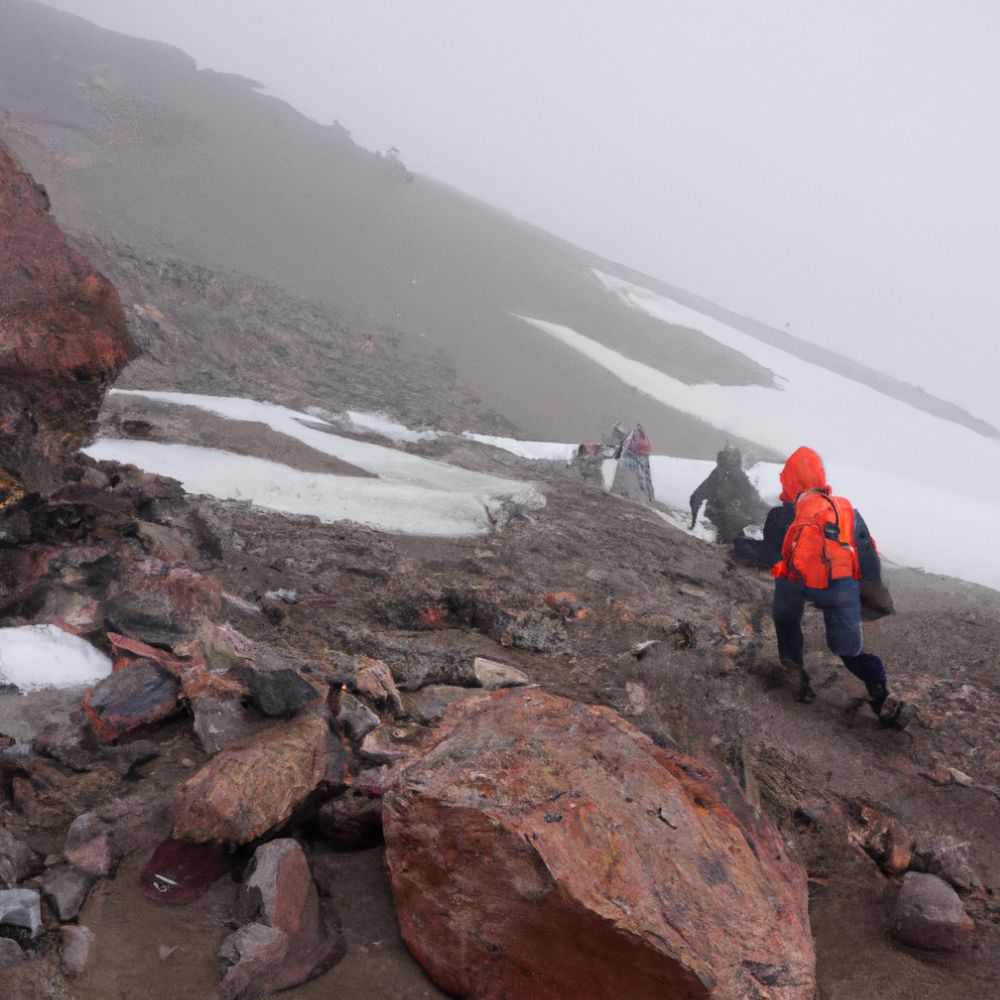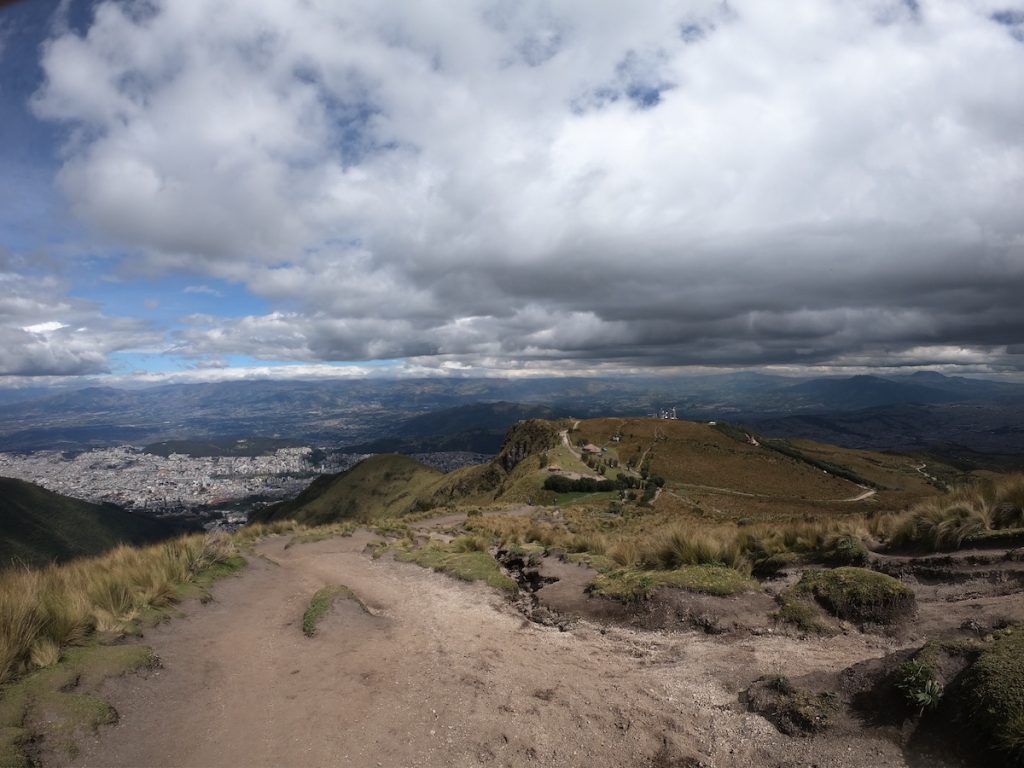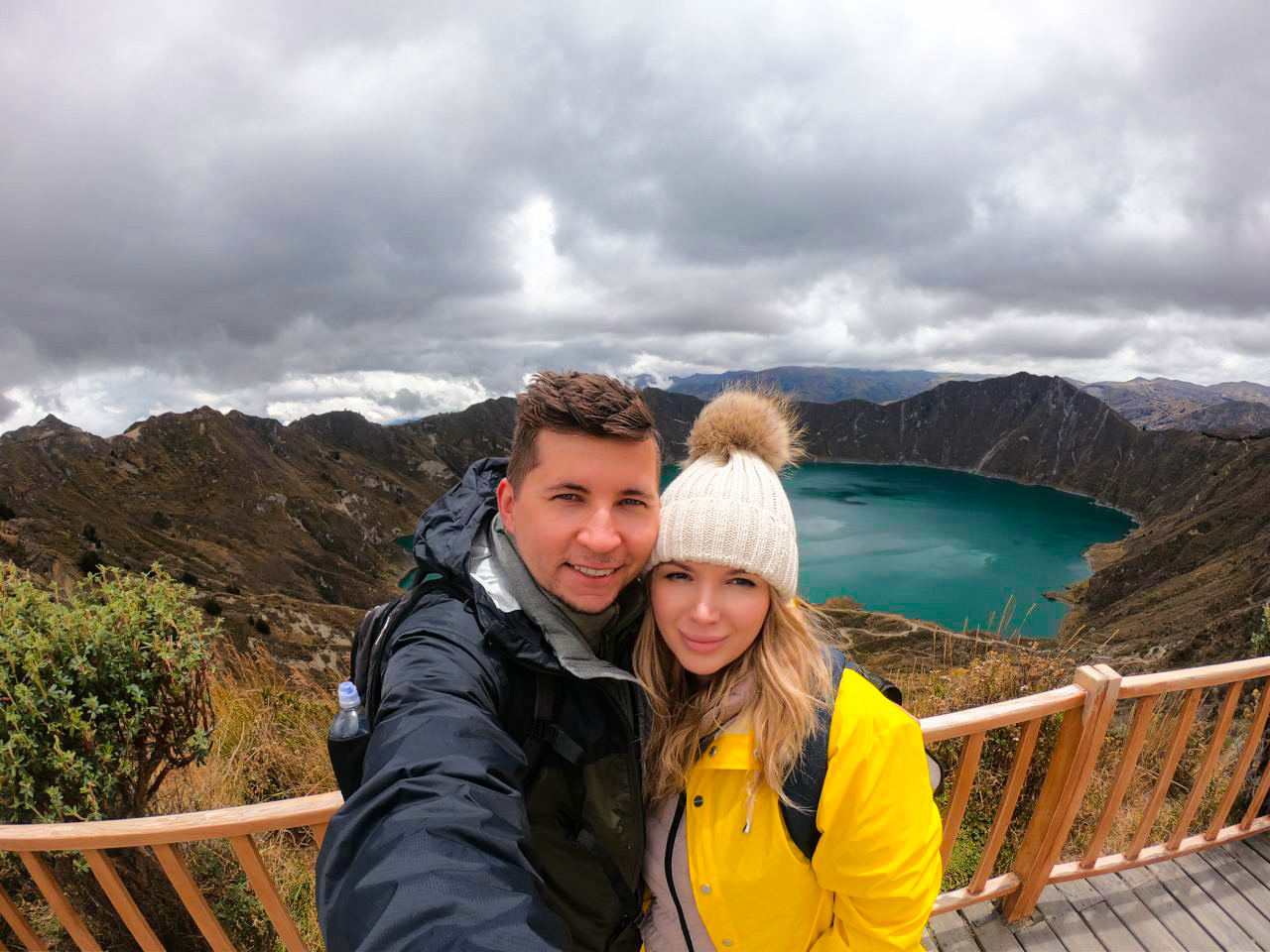Mount Chimborazo is Ecuador’s highest peak, and climbing it is considered one of the best activities to do in Ecuador. The Chimborazo climb is non-technical, meaning you won’t face steep vertical cliffs requiring ice-climbing skills, making it accessible for those with basic mountaineering experience.
Standing at 6,268.2 meters (20,565 feet), Mount Chimborazo’s equatorial peak is the closest point on Earth to the sun, as it’s the highest mountain when measured from the center of the Earth, rather than from sea level.
Climbs to Chimborazo typically begin between midnight and dawn, with many successful summit attempts reaching either the minor Veintimilla Peak at 6,230 meters (20,440 feet) or the major Cumbre Maxima peak at daybreak. To help combat the effects of altitude sickness, taking ChlorOxygen supplements while climbing may be beneficial. Also, it’s a very good idea to get a guided tour for best experience.
Climbing Chimborazo was an unforgettable adventure for me. Ready to tackle Ecuador’s highest peak? Let expert local guides craft your ultimate Chimborazo climbing experience with a FREE personalized tour plan. Your booking supports this blog and helps sustain Ecuador’s mountain communities.
Table of Contents
Where is Chimborazo Located?
Chimborazo Volcano, located in the high Andes of Ecuador, sits about 235 kilometers south of the capital city, Quito. The nearest city is Riobamba, found in Chimborazo Province.
Surrounded by the Chimborazo Wildlife Reserve, the volcano is nestled within a vast protected area spanning nearly 60,000 hectares. This sanctuary is home to herds of wild vicuñas, which add a touch of enchantment to the region.
Vicuñas are like the smaller, adorable cousins of llamas and alpacas. These captivating animals are known for their incredibly soft and lightweight wool, which is often considered finer than cashmere.
How to Get To Chimborazo
To reach Chimborazo, start by taking any southbound bus from Quito‘s Quitumbe terminal to Riobamba. The fare is around $3.75, and the journey will take a little over three hours.
From Riobamba, head to the Terminal Terrestre and take a bus to Guaranda, asking the driver to drop you off at the Chimborazo entrance, which is about 30 minutes after passing through San Juan town.
Alternatively, you can take a taxi to the trailhead, located about a half-hour drive from the Whymper Hut, the starting point for many Chimborazo climbs.
Also, if you’re staying in Riobamba, you can be picked up directly from your accommodation if you take this tour.
How High is Chimborazo?
Chimborazo, a massive ice-capped stratovolcano, towers at an impressive elevation of 6,310 meters (20,703 feet). Its most recent reported eruption occurred in 550 AD, marking a significant event in the region’s volcanic history.
With a circumference of 78 miles and a diameter of 30 miles, Chimborazo commands a dominating presence in the Andean landscape. Once considered an extinct volcano, recent studies have revealed that Chimborazo is still active, although its activity remains minimal, reminding us of its geological force and historical significance.
Is Chimborazo Really the Highest Peak in the World?
From a scientific perspective, Chimborazo holds a fascinating distinction. While Mount Everest stands taller when measured from sea level at 8,848 meters (29,029 feet) compared to Chimborazo’s 6,268 meters (20,565 feet), Chimborazo doesn’t even rank among the top 100 highest mountains in the world.
However, due to the Earth’s oblate shape, which causes the equator to bulge outward slightly, Chimborazo’s summit is the farthest point from the center of the Earth. Positioned just one degree south of the equator, Chimborazo is farther from the Earth’s core than Everest, which is located at 27.6 degrees north.
To put it into numbers, while Everest’s peak is 6,382.3 km above the center of the Earth, Chimborazo surpasses it at 6,384.4 km. This surprising discovery, made in 2012, is even more fascinating when considering that Chimborazo isn’t the tallest mountain in the Andes, ranking only 37th in height.
Best Time To Visit Chimborazo
The best months to climb Chimborazo are June and July, as well as December through early January, when the Andean weather tends to be more favorable for climbers. During this period, which coincides with Ecuador’s summer, the weather is generally sunny, with daytime temperatures reaching around 23°C (73°F), making it comfortable for outdoor activities.
However, temperatures drop significantly at night, typically falling to around 7 or 8°C (45-46°F). As you ascend toward Chimborazo’s towering peak, the temperatures decrease further. Strong, cold winds and icy conditions are common in the mountain’s upper reaches, regardless of the season, making preparation for such conditions essential.
From February to May, particularly in April, the weather is less favorable due to prevalent bad weather, so it’s best to avoid climbing during this time.
Make it a point to start your climb before midnight and to return by 10 a.m. for the following reasons:
- First, there are risks of rockfall. Around that time, the route around The Castle, a massive rock wall about an hour from the Refugio Whymper, becomes treacherous. As the temperature rises, a great number of tiny and large rocks begin to fall from the high wall.
- Later in the afternoon, passing across this region (El Corredor) is like dashing between falling rocks.
- Second, clouds frequently roll in early in the afternoon, making it extremely difficult to find the route. Because there are large crevasses on both sides of the regular trail, losing track may be quite perilous.
Starting Point
Riobamba is an ideal starting point for an expedition to Chimborazo, offering convenient access to the Chimborazo Reserve. Located about 120 miles (200 km) from Ecuador’s capital, Quito, Riobamba is easily accessible by bus from the Quitumbe bus station, situated just south of Quito.
Plan perfect trip to Ecuador & Galapagos
I spent countless hours researching everything about traveling to Ecuador, and I created this blog for fellow travel enthusiasts who want the best, most reliable information. But if you want to save time, we’ve partnered with the top local agency to plan your dream trip.
Once you arrive in Riobamba, getting to the Chimborazo Reserve is straightforward. You can take a bus bound for Guaranda and ask to be dropped off at the Reserve entrance. Alternatively, a taxi ride from Riobamba to Chimborazo costs around $35.
For a more hassle-free experience, many guides and tour operators offer comprehensive packages that include transportation to Chimborazo. When booking, you can discuss pick-up arrangements and transportation logistics to ensure a smooth trip.
Chimborazo Routes
There are several routes available for climbing Chimborazo, each offering a unique challenge. Among the more accessible routes are:
- North Side via Las Murallas Rojas
- North Side via El Castillo (the most popular)
- The Original Route (first conquered in 1880)
These routes are classified as grade 2 on the UIAA scale, meaning they require solid climbing techniques and preparation. Climbing Chimborazo is not a typical volcano hike; it demands proper technical skills, which can be acquired with training. The ascent typically takes 8 to 9 hours, with the Original Route involving a 4,300-foot climb, while the other two routes encompass a 3,900-foot ascent.
For experienced climbers, the West Face route offers a more challenging ascent, classified as WI4, requiring climbers to navigate ice walls using ice picks and crampons. Some sections are near-vertical, reaching heights of up to 30 feet, adding a thrilling dimension to the climb. The high altitude further intensifies the difficulty, making acclimatization and endurance crucial.
For those seeking the ultimate challenge, the Arista del Sol route, classified as grade 5, is the most demanding. This route begins with 65% rock climbing and takes around two days to complete, requiring advanced climbing skills and strategic planning.
Reaching Chimborazo’s summit through these technical routes is a true testament to a climber’s skill, determination, and passion for mountaineering. The experience of scaling ice walls, maneuvering through rock formations, and enduring the high-altitude terrain is nothing short of extraordinary.
Best Time to Climb Chimborazo
The best months to climb Chimborazo are June and July, as well as December through early January. From February to May, particularly in April, bad weather is prevalent.
It’s essential to start your climb before midnight and aim to return by 10 a.m. for two key reasons:
- Rockfall Risks: As the temperature rises later in the day, the area around The Castle (El Castillo), a massive rock wall about an hour from Refugio Whymper, becomes dangerous. Rocks, both large and small, begin to fall from the high wall, making El Corredor treacherous. Crossing this area later in the day feels like running through falling debris.
- Poor Visibility: Clouds typically roll in by the early afternoon, making it extremely difficult to see the route. Given the presence of large crevasses on both sides of the regular trail, losing track of the path can be dangerous.
To mitigate these risks, timing is crucial—plan to summit and descend early to avoid rockfalls and poor visibility.
Chimborazo Acclimatization and Climbing Preparation
Climbers are advised to spend time at high altitudes before attempting a Chimborazo summit to gauge how their bodies respond to the extreme conditions on the mountain. I would also recommend taking ChlorOxygen supplements 1-2 weeks ahead of the trip, as it can help in coping with high altitudes.
Engaging in challenging hikes in Ecuador’s central Andes is a great way to acclimate. Routes like the El Altar’s lagoons hike or the Ecuadorian Inca Trail in Sangay National Park provide excellent opportunities for your body to adjust to the altitude, preparing you better for the demands of climbing Chimborazo.
Things to Bring to Your Chimborazo Climb
The Chimborazo climb is not for beginners, so make sure you have the proper equipment to complete the trip and survive the cold temperatures you will encounter along the journey, which range between -3°C and -15°C.
While most tour operators provide their own climbing equipment, it is still recommended to bring your essentials such as:
- Medium backpack for the ascent
- Refillable water bottle
- Sunscreen with a high SPF (50 SPF or higher)
- Lip balm
- Clothing: thermal underwear, hiking socks, t-shirt, waterproof jacket, and pants
- Sunglasses
- Personal hygiene items
- Face mask
- Alcohol-based disinfectant
Camping in Chimborazo
Most groups begin their ascent of Chimborazo from the Whymper Refuge at 5,000 meters (16,400 ft). The refuge is equipped with basic but essential amenities such as bunk beds (with fresh mattresses), toilets, cold water, basic food supplies, stencils, a gas stove, and a fireplace. It offers about four dozen beds, providing a comfortable base for climbers.
Similarly, the Carrel Refuge at 4,800 meters (15,744 ft) offers the same amenities, with 52 beds available. However, staying at Carrel means starting the ascent one hour earlier than those at Whymper.
For those looking to improve their chances of summiting, camping is permitted anywhere on the mountain. Some groups opt to set up a high camp, which shortens the summit push to two days. I believe this strategy significantly boosts your chances of reaching the summit by breaking the climb into more manageable parts.
The most highly recommended are:
El Castillo High Camp
The El Castillo high camp is situated at the bottom of a bowl, just a few meters beyond the rock outcrop on the left (north) side of the Southwest ridge, which is the normal route for climbing Chimborazo. While it provides a strategic location for breaking up the climb, it is important to note that this camp can be risky under certain conditions.
If there is new snow on the first dome, this camp is vulnerable to avalanches and the windblast they can generate from above. Therefore, setting up camp here is not advisable in such conditions, as the location lacks protection from potential avalanche risks.
Moraine Camp
The Moraine Camp, located at 5,050 meters and just 10 minutes from the Whymper Refuge, is a popular option for climbers looking to set up camp near Chimborazo’s summit route. This area offers a large flat field, making it convenient for camping.
However, it’s crucial to pitch your tent as far away as possible from both the moraines and the Thielman Glacier to minimize the risks associated with shifting ice and rockfalls. The location provides a great base for the climb while offering relatively more safety if chosen wisely.
Note: As of November 2021, refuges no longer provide service or accommodation and all climbs will begin from a high camp at 5,200 meters.
Dreaming of summiting the closest point on Earth to the sun? Get a FREE custom itinerary from my trusted local partners and take the guesswork out of planning your Chimborazo climb. Supporting this blog and Ecuador’s local communities has never been easier!
Altitude and Safety Tips
Climbers attempting to summit Chimborazo will face extreme altitude, which can be challenging even for experienced mountaineers. Altitude sickness is a serious risk that must not be overlooked. Taking chlorophyll supplements, like ChlorOxygen, in the weeks leading up to the climb may help alleviate symptoms, but it is essential to be mindful of your body’s signals.
Common symptoms such as shortness of breath, an elevated heart rate, and fatigue are expected when trekking at high altitudes. However, more serious signs like chest pain, intense headaches, or coughing up fluid indicate it’s time to stop the climb and prioritize safety.
Proper acclimatization is essential before attempting Chimborazo. It’s strongly recommended to spend time at high altitudes beforehand to help your body adjust. This mountain is not suitable for beginners, and it can be dangerous without the right preparation. If you’re prone to altitude sickness, bringing the necessary medications and a first aid kit is crucial, and avoiding strenuous activities altogether may be wise.
By law, you must hire an accredited guide to climb Chimborazo. These guides are trained to ensure climber safety, but it’s critical to listen to your body and carefully consider whether you’re ready for such a demanding climb. Safety should always be the top priority when tackling Ecuador’s highest peak.
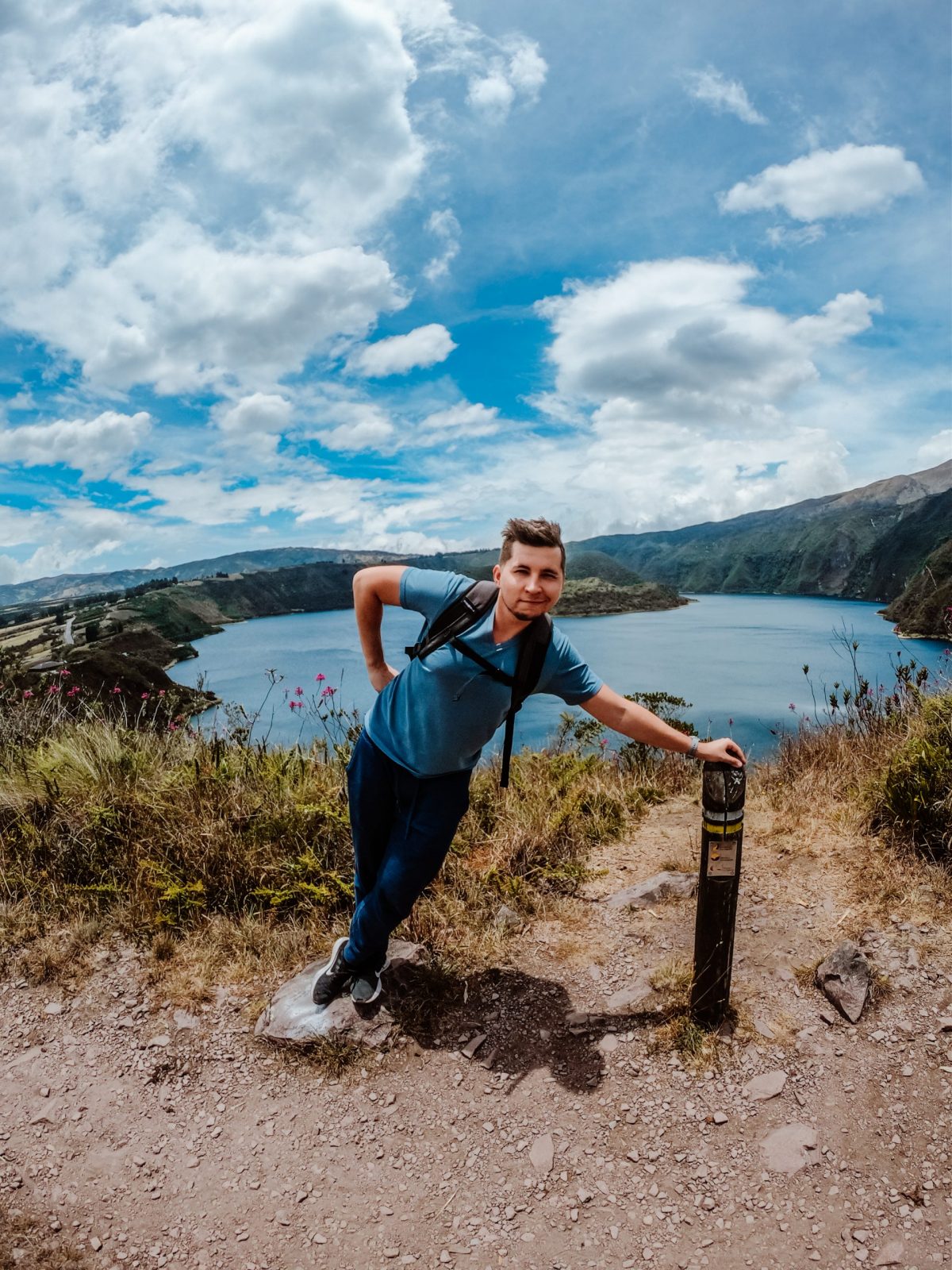
Planning trip to Ecuador?
My wife and I rented a car for 15 days and traveled from the northern part of Ecuador to the south, visiting amazing cities like Quito, Otavalo, Baños, Cuenca, and Guayaquil. Along the way, we explored iconic places such as Cotopaxi National Park, Quilotoa Lake, and many more breathtaking destinations.
Not many blogs cover traveling in Ecuador in detail, so I spent nearly three weeks creating this comprehensive Ecuador travel guide based on our trip. It’s packed with everything you need to know, and honestly, I consider it the best free travel guide about Ecuador out there.
If you’re planning a trip to Ecuador, don’t forget to use my link for discounted hotel prices through Booking.com. It’s a great way to support my blog while saving money on your accommodations!
Conclusion
While Chimborazo may not boast the highest elevation, its unique geographic location makes it truly remarkable. Its summit is the farthest point from the Earth’s center, an awe-inspiring fact that adds to its mystique.
Climbing Chimborazo offers diverse experiences, from less technical routes for those with basic climbing techniques to more advanced, challenging ascents requiring skill and expertise. Adventure seekers will find a thrilling challenge here, whether trekking or tackling the technical climbs.
If you’re in search of an adrenaline-packed experience, Chimborazo is a destination worth adding to your Ecuador itinerary!

